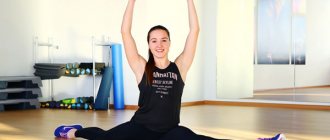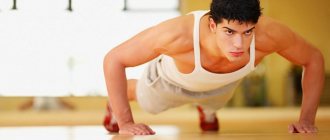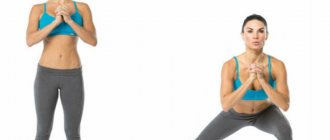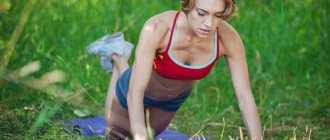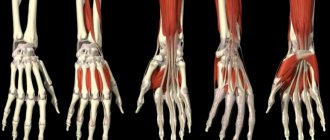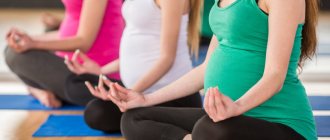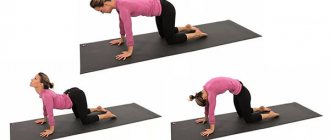Anyone who even occasionally plays sports knows how important stretching is. It develops flexibility, strengthens tendons, improves blood circulation and, of course, helps avoid injuries during active training in the gym.
It is indispensable for people suffering from diseases of the lumbar region: it relieves pain, improves posture and heals the body as a whole, increasing endurance and coordination of movements. In this article, we have prepared for our readers 10+ first stretching exercises for beginners at home, as well as brief recommendations on how to perform them correctly.
Why do you need to stretch?
Stretching is not a separate sport, despite the fact that it resembles yoga, but an integral component of any activity, be it athletics, fitness, tennis, or especially dancing. Stretching is especially necessary for people who are far from such activity, because with a sedentary lifestyle, the elasticity of muscles, ligaments and joints is lost even more rapidly. As we age, we all become less flexible and graceful, and the risk of injury during sports increases. And only stretching can keep all the muscles of the body toned. Therefore, stretching today is an incredibly popular activity, both in special studios and among home athletes. Regular stretching is simply necessary for those who dance, build the muscles of their body, or dream of improving their results in their favorite sport.
Stretching brings incredible benefits to the entire body, preventing salt deposits, the development of varicose veins, obesity and other major ills of our century.
Plus, stretching can improve blood circulation, oxygen flow to the brain through proper breathing, and give a feeling of calm after a busy day at work.
Online stretching exercises for home
While most of us understand the basic idea of stretching, not many understand how it works.
A typical stretching video may tell you how to stretch, but few will explain why it's so important. Online stretching exercises will help you avoid injury during exercise.
The human body is made up of muscles and tissues that support the skeleton. The bones of the skeleton are connected to each other by ligaments, the muscles are attached to the bones by tendons. Ligaments and tendons are like flexible ropes made of many fibers.
When we stretch, we force these fibers to stretch in one direction or another. When exercised gently and carefully, these fibers become more elastic, which increases our mobility. Stretching regularly increases the range of motion a joint can perform. Simply put, our flexibility increases.
Contraindications
Contraindications to stretching include cancer, spinal injuries, joint pathologies, the postoperative period, diseases of the cardiovascular system and inflammation, which are accompanied by high fever. If in doubt, you should consult your doctor.
Before practicing stretching lessons for beginners, it is worth considering that when stretching you cannot chase quick results. It is better to start with the smallest loads, gradually increasing them. The main thing in stretching training is regularity and smoothness. Experienced trainers advise stretching every day for half an hour. The classes do not require special equipment, so you can do stretching at home.
Basic principles of exercises
The main principle of stretching is smoothness of movement . Classes to increase flexibility are always held at a slow pace, without jerking, to relaxing music.
There should also be no severe pain in the muscles and ligaments - you need to stretch until discomfort appears. Pain is a signal of overstretching and possible rupture of ligaments or muscle fibers. It is important to listen to your body and not force things.
several rules when practicing stretching :
- stretch only on warmed muscles - 10-15 minutes before exercise you need to give them a load: run, jump or do several active movements that will improve blood circulation and increase the temperature of muscle tissue;
- it is necessary to monitor your breathing - stretch as you exhale after taking a deep breath through your nose;
- train in comfortable clothes that do not restrict movement;
- hold the static position at the extreme point for up to 15-45 seconds.
Graduality and systematicity are prerequisites for stretching exercises, otherwise injuries cannot be avoided.
It is impossible to immediately do the splits without proper preparation - months and sometimes years of training are needed. Moreover, they should be at least 3-4 times a week, and even better, stretch every day. Long breaks in classes lead to a loss of progress and set you back several steps.
Stretching for beginners at home
The essence of stretching is to alternate between muscle tension and relaxation. Only a pre-warmed body will succumb to stress without pain, so before stretching, you need to jump a little, dance or do a few aerobic exercises. It is necessary to stretch all muscle groups, starting from the neck and ending with the feet. 15 minutes is the optimal time for “warming up”.
When it comes to stretching, the principle “the more often the better” works 100%. If your goal is to do the splits, then you need to get used to daily stretching. This way the muscles will constantly feel the load and gradually succumb to this condition. Do not forget that all the muscles of our body are interconnected, so working on stretching only one leg is not enough. If you want to do the splits, pull your abs, obliques, and calves. This is how human flexibility develops comprehensively. And even though the system seems complicated at first glance, after just a couple of weeks of regular exercise, the first results will be noticeable, and stretching will turn into a habit. You should exercise in comfortable clothes. And one more thing: after each workout, the muscles will be very grateful for a light massage.
A daily stretching routine at home may look like this:
- Starting position - sitting on the floor with your legs bent under you, your buttocks not moving away from your heels. Bend over and stretch forward so that your shoulders and head are as close to the floor as possible. Stretch your arms forward. Hold this pose for a few seconds, then return to the starting position. Repeat 15 times.
- The starting position is the same, but the feet are already spread apart, and the buttocks are on the floor between them. Slowly and carefully spread your feet in different directions at the maximum angle. The back should remain straight. Repeat 15 times.
- From a standing position, we lunge wide forward so that one of the legs is bent at an acute angle, and the other is straight. We shift our body weight forward and remain in this position for a while. Repeat 5 times on each leg.
- Side lunges. Taking a wide step to the side, we try to sit on our leg as deeply as possible. Having “sprung” a little, we slowly transfer the weight to the other leg and stretch it.
- Starting position – sitting on the floor with legs extended forward. Slowly we bend towards our feet and try to pull ourselves up as close as possible. It is better to perform 10 approaches, holding out as long as possible.
- The starting position is the same. We grab one leg with our hand in the foot area and pull it towards the face as close as possible. Both legs and back should remain straight. Hold for about 30 seconds and repeat the exercise with the other leg. 5-10 approaches.
- Starting position – sitting on the floor, with your legs spread to the side. We place one leg on the thigh of the other, touch the foot of the other leg (it remains extended) with the tips of our fingers and stretch our chest down. You should remain in the bend for a while, then repeat the exercise with the other leg. And so – 5-10 approaches.
- Starting position – sitting on the floor with straight legs extended forward. Bending one leg at the knee, we move it over the other and place it on the foot. Then we bend over to the straight leg, fix the position for 30 seconds and return to the starting position. Then - the same thing, but with the other leg. 5-10 approaches.
- Everyone knows the “butterfly”. We sit on the floor, our feet are brought together in front of us, our knees are spread out to the sides as much as possible. We bend over, fix and back - 15 approaches.
- Starting position – sitting on the floor, one leg straightened, the other leg laid back and bent at the knee. The foot of the extended leg is towards you, the foot of the bent leg is close to the thigh. We bend towards the straight leg, fix it, then forward and also linger in this position. We repeat the same with the other leg. All together - 10 approaches.
These basic stretching exercises will tone the main muscle groups and help you do the longitudinal and transverse splits. On the Internet you can find a video with a detailed analysis of each position. You should start training after a good warm-up. The fixation time from 30 seconds must be gradually increased to 5 minutes.
5+ main types of stretching
Your stretching sessions can consist of one type of load or a complex that includes exercises from all directions. In total, there are six main types of stretching for beginners, which are especially convenient to do with visual video tutorials - there are many of them on YouTube.
Passive stretching with a partner
You take the required body position, your partner works on your muscles by progressively increasing efforts. For example: you stand near a wall, straighten one leg at an angle, and a friend tries to lift it as high as possible and hold you in this position. Your work in this case is passive.
You will need a partner for passive and resistance stretching.
With resistance
It is performed similarly to the passive one with a partner, but you provide resistance to him with the force of muscle tension.
Static
Take the desired position and, having reached the extreme point, freeze, after which you return to the starting position. This type of stretching is popular among professional athletes because it minimizes the risk of muscle tightness.
Ballistic
Consists of springing exercises performed at a fast pace. It is performed with maximum amplitude, which makes it dangerous and not suitable for beginner athletes. You can start ballistic stretching with decent sports experience behind you.
Isolated
Important for increasing springiness and muscle strength. Once you reach a certain position, you stay there, using a specific muscle group without outside help. Also suitable for professional athletes.
You can do the exercises at home, in the gym, and in the fresh air.
Dynamic
It is produced before strength and cardio training and promotes weight loss. Consists of swinging arms, legs, lunges, raising on toes and running in place, allows you to qualitatively prepare the body for physical activity.
Tip: a set of stretching exercises for beginners can be easily performed at home, accompanied by educational video lessons.
A little about twine: types and tips for beginners
Although doctors and teachers talk about the need for comprehensive stretching for health, many girls see it exclusively as a path to their dream - an elegant split. Stretching as a set of exercises will really help you achieve your goal, but only with regular exercise. Note that the easiest split is considered to be the longitudinal one, when one leg is in front and the other is behind. Transverse stretching is much more difficult, so it is better to sit on a “straight” split when you have already managed to develop a “left” or “right” split. A completely realistic period in which you can achieve good stretching and do the splits by practicing regular stretching at home is a month.
Note that to achieve the best result, “springs” when stretching should be alternated with static positions. “Springing” is easier, so training is usually started with this method. Just no sudden movements or jerks - extremely smooth rocking with small amplitude. It is better to add statics gradually; it is most effective, but this method is difficult for beginners to overcome. This makes it easier to relax while stretching, which is very important, since only muscles at rest are subject to tension.
Doing the splits while training at home requires incredible discipline. If you feel that your motivation may not be enough to fulfill your dream, entrust it to a professional trainer! Stretching classes for beginners are held at the dance club “La Boca” under the guidance of a qualified teacher. The unique technique used here combines strength training and stretching of the muscles and joints of the whole body. The result will be a surge of vigor, increased flexibility of the body, improved clarity of the lines of the figure and, of course, the long-awaited splits! We invite you to stretching lessons in St. Petersburg - at the dance club “La Boca”!
Description of some effective stretching techniques
Stretch is our instinct. We stretch when we yawn or when we wake up, although no one taught us this. Online stretching workouts simply tap into that instinct and present familiar movements in a structured way.
One of the most popular techniques at Motify is stretching yoga. It combines stretching with the physical and mental health benefits of yoga.
Some of our trainers have ballet training. During stretching lessons, they share the amazing secrets of their dance flexibility.
Motify online video workouts are aimed at overall health of mind and body. You can also find exercises here that combine stretching and meditation. They are especially popular with those who need quick, comprehensive results with little free time.
We recommend that you work out with different trainers and try different stretching exercises. Combine several techniques to work different parts of the body and use the variety of exercises presented so you never get bored.
Features of a set of exercises for flexibility of the whole body for beginners
Each person can choose a set of exercises for themselves if they find the exercises below unsuitable for some personal reasons. Unlike other types of physical activity, there are absolutely no restrictions.
Features of a set of exercises for flexibility of the whole body for beginners
Anyone, regardless of age, gender and physical fitness, can perform body flexibility exercises for beginners . Train your body, achieve higher plasticity and stretching of joints and muscles, by saturating them with fresh oxygen during training. For higher efficiency, you should follow a few simple rules.
We complicate the stretching training program
After completing the warm-up, you can begin the dynamic part of stretching. To do this, you can watch the course “ Stretching video lessons for beginners .” At the beginning, you need to perform rotational movements, gradually trying to fix the body in the desired position. This will contribute to the springing effect.
We complicate the stretching training program
Next, you can begin the so-called ballistic exercises. The main nuance here is that a person gradually increases the amplitude during movements. Swings must be done with both legs and arms.
- The next step in stretching for a beginner is to move on to isolated stretching. It will help increase muscle strength. During this workout, you can relax your body. You can also try to do the splits slowly and leisurely, but you don’t need to get too carried away.



